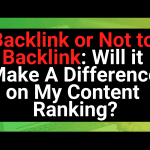If you’ve been trying to build a strong online portfolio of your business and doesn’t have hundreds of millions of dollars to spend on lavish marketing tactics, going for direct response marketing would be a smart move. In direct response marketing, marketers make use of certain techniques to get a potential audience to perform a certain action. The actions are chosen by marketers.
For instance, using pop-up pages to let potential audience enter their email address or asking users to comment on what they think about your product, service, or blog. In simple words, you want visitors to perform actions that benefit you in some way. And trust me, it isn’t that simple to generate leads with direct response marketing.
Is Direct Response Marketing Important?
Yes, direct response marketing can turn in a greater number of leads, sales, and other information. But unlike most marketing techniques, direct response marketing takes time to yield results. However, marketers start analyzing the outcomes as soon as it is enabled to the targeted potential audience.
Consider you set up a landing page to let customers enter their name and email, now if the direct response rate is higher, then the campaign is doing well. And if you’re not getting enough response, there’s a problem with your landing page. You might be using the wrong information, call-to-action, or misleading users from the start. Therefore, as long as you’re on the right track, direct response marketing plays a key role in sales generation.
Techniques to Make Your Direct Response Marketing a Success
As discussed earlier, the higher direct response rate is the main goal of direct response marketing. Whether you’re getting people to sign up for an event, buying a product, or enter certain information, follow the below two techniques to make your direct response marketing a success:
* Less is More
Making the process simple for the potential difference is the first thing that makes a difference. Make it easy for your potential customers to respond to your instructions. A simple landing page with an ordinary message to direct customers what you want to do will just do fine. Moreover, make sure to add your contact information, any certificates, and brand name up above to let customers know what they’re dealing with.
* Work on Your Reputation
Purchasing from a brand with no experience definitely raise questions? Similarly, when targeting potential customers, they’ll definitely question your credibility. The best way to combat such situations is by adding customer testimonials, success stories, reviews, and any certificates on the landing page. All these things positively impact the customer’s behavior – leading to a higher response rate.
I hope you all now have a clear understanding of how direct response marketing works and how to generate more leads with the aforementioned techniques. Note that call-to-actions are must-haves of direct response marketing and if employed correctly, they definitely get higher response rates.
Important Rules to Remember When It Comes to Direct Response Marketing
With any marketing campaign comes rules, so this form of marketing is no different. It is important that you are clear of certain rules when it comes to Direct Response Marketing in order to be successful.
* Communicate Clear Instructions:
Simply put, relay to the consumer how, what, and when you want them to do something. It is also important to make clear as to what is going to happen once those things are done.
* Having an Offer:
Think of it as being in the biggest game of the season and you are holding the ball that could score the winning point. Your main focus is to make that shot in order to win the game. The same goes with direct response marketing, your main goal is to make that sale. Your focus right now is not to build your brand but instead to make sure your ad always make that important offer that will entice your prospects to react, respond, and buy.
* Set a Clear Deadline:
Urgency is the only goal you should be focused on. Your ad should always include a clear and precise deadline. Why? You don’t want people to believe they have until tomorrow or next week to respond to your ad. The expectation should be that they respond immediately in order to get in on a great deal or else they run the risk of missing out on something great.
* Track:
In order to know what is working and what is not, you want to make sure to have systems in place to track and measure certain data points. The key here is to zone in on what offers are taking the bait and which advertisement campaigns are working to make this happen. There is too much technology at our fingertips to not make this simple step happen.
* Call-To-Action:
So, what’s next? The offer has been made. Your prospects have been convinced that they needed to respond immediately in order to get that great deal. This is where your clear instructions come in. What is it that needs to be done to finalize that offer?
Do your visitors need to give a like on your social media platforms? Do they need to sign up for something else? Do they need to be scheduled in to receive a phone call or a text? Simply put, transparency is vital!
* Branding vs. Direct-Response:
Know the difference because there is a huge one. This is one of the most important rules to remember and for good cause. Direct response marketing is meant to attract your consumer immediately to take advantage of that special offer now. Branding is more about the feature or the property or product itself. Your main goal with this form of marketing is to focus on what the benefit of that product or feature will be to your targeted audience.
* Follow Up:
Take advantage of every opportunity if a prospect reaches out to you, and give as much information as you can. If they are making contact with you that means they are interested in what you are offering. So get them while they are hot, at the least, make sure you get their email, name, and address and add them to your newsletter mailing list. Don’t have one? Start now! The next thing to do is follow-up and not give up.






